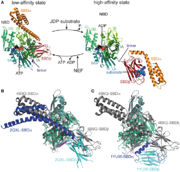3D2F is a complex formed with two proteins Sse1p and Hsp70. Both have a role in helping protein folding. The interaction of Hsp70 with Sse1p catalyse the liberation of Hsp70s’ ADP and triggers the good folding of the substrat.
Relevance
Hsps are found in eukaryotes, eubacteria and some archaea. The formation of the 3D2F complex is really important. Mutations modifying the interaction between the two proteins usually impair the growth of cells. And suppressing the nucleotide exchange factors activity of Sse1p can lead to death of mutans. It shows the importance of Sse1p for Hsp70 and in the folding of proteins.
Structural highlights
Hsp70
Hsp70 is a family of proteins. They chaperone plenty of cellular proteins and their role is to help the good folding of proteins by preventing aggregation and degradation and help protein transport across membranes.
Hsp70 is composed of two chains and is 382 nucleotides long. It’s molecular weight is 70 kDa. It can be linked to different ligands such as ATP and ions like potassium or magnesium. [1]
They are composed of a N-terminal ATP binding domain called Nucleotide Binding Domain (NBD) and a C-terminal Peptide-Binding Domain (PDB). The PDB domain is composed of a ß-sandwich part and an α-helical bundle.
The aim of the NBD is to regulate the activity of PDB for the substrate binding and release.
Conformational cycle of Hsp70s [2]
Hsp70s recognizes a short degenerate sequence motif, present in most polypeptides.
They are ATP dependent chaperones and interact with cochaperones of the J-domain protein family. They also work with chaperones of other families such as small Hsps (Hsp110 in 3D2F). Hsp70s interact with proteins when they are in denatured state because the motifs recognized by Hsp70s are generally found during stress denaturation, translocation through membranes or during synthesis when emerging from the ribosomal exit tunnel.
Ssep1p
Sse1p is a protein from the Hsp110 family. It is located in the cytosol and ER of most eukaryotes. It can act as chaperone or co-chaperone with Hsp70 in the protein folding.
Sse1 is composed of two chains and is 675 nucleotides long. The name of the gene coding for this protein is SSE1 (MSI3). It can be linked to different ligands : ATP, ions as potassium or magnesium and glycerol.
The Hsp110 family is composed of two proteins Sse1p and Sse2p. Sse1p is constitutively expressed while the production of Sse2p is stress dependant.
Hsp110 proteins are homologous to Hsp70. The general domain organisation of Sse1p ressemble to one of the canonical Hsp70s. They are composed of different domains: a N-terminal actin type Nucleotide-Binding Domain, a ß sandwich domain and a C-terminal 3 helix bundle domain (3HBD).
All the interaction with the NBD of Hsp70 is located along the NBD and 3HBD of the Sse1p. The interaction with Hsp70 only causes minor changes in its conformation.
When interacting with Hsp70, Sse1p’s NBD is bound with ATP. However, the hydrolysis of ATP and associated allosteric rearrangement seems to be dispensable to the cycle of Sse1p and to the formation and dissociation of the complex.
The NBD is twisted in two lobes. The twisted lobe arrangement is stabilized by the contact with the γ phosphate of the ATP, by the ß-sandwich domain and the N-terminal part of the 3HBD. All this interactions ensure a good formation of the complex with Hsp70.
The ß-sandwich domain, is relatively poorly conserved in Hsp110 proteins and its importance in the formation of the complex with the Hsp70 has still to be determined.
Complex activity
The activity of the protein Hsp70 is tightly regulated by different proteins. One kind of proteins will help the hydrolysis of ATP (J-domain proteins) and NEFs (Nucleotide Exchange Factor) which are another kind of proteins will remove the ADP from Hsp70.[3] Sse1 is a NEF, its main function is to catalyse the nucleotide exchange on Hsp70, thereby increasing the rate of the activity of Hsp70.
In the activity cycle of Hsp70, unfolded protein are recruited by Hsp70 with the help of J-domain proteins. J-domain proteins binding triggers the ATP hydrolysis in Hsp70 protein. The transformation of ATP into ADP leads to important conformational changes : the PDB domain of Hsp70 adopts a close conformation and binds tightly to the substrate. It’s at this step that intervene Sse1ps. They interact both with Hsp70 and the unfolded protein. The interaction of both the unfolded protein and the chaperone might promote the formation of the complex.
The Hsp70’s PDB which is tightly linked with Sse1p ATP-bound NBD is considered to be the part of the protein helping in the remodelling of misfolded proteins. During this step Hsp70 ADP is liberated. It is the formation of a new bond between Hsp70 and an other ATP that may trigger the dissociation of the complex and the partial or complete folding of the protein. If the protein has not been completely folded, it can bind again to Hsp70 for a new folding cycle.
When interacting with Hsp70, Sse1p’s NBD is bound with ATP. It’s NBD and 3HBD are tightly interacting with the NBD of the Hsp70.
The NBD of Hsp70 is clamped between Sse1’s NBD and 3HBD and rotated 27° sideways with respect to the rest of the NBD. In this configuration, Hsp70’s adenosine and trisphosphate binding sites are moved apart, thus diminishing the affinity for the ADP. This change of conformation facilitates the dissociation of Hsp70 with the ADP.
The surface of interaction between Sse1p and Hsp70 is approximately of 1760 Ångström². Nearly all the length of the Sse1p’s peptide sequence is required for the formation of the complex. It’s mostly composed of polar amino-acids and including lots of Hydrogen bonds both between the proteins and water.

